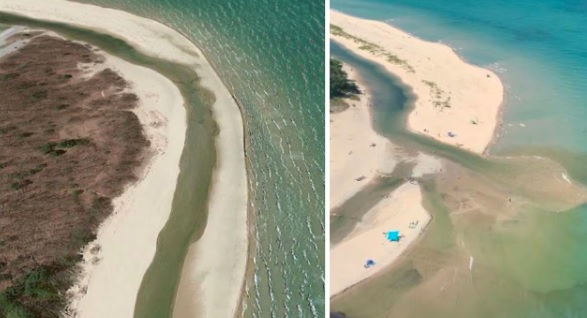A Michigan man has been convicted in federal court of illegally diverting a river with a simple shovel and some rocks.
Andrew Blair Howard was arrested after he built a small dam out of rocks in August of 2022. The man’s digging caused a change in the flow of the Platte River near Michigan’s Sleeping Bear Dunes National Lakeshore.
Howard was convicted this month on charges of tampering and vandalism at the state park, according to a news release from the U.S. Attorney’s Office of the Western District of Michigan.
It appears that the 63-year-old man had dug a channel by hand to cut through a section of sand that had built up along the Platte Point shoreline which was making access to and from Platte Bay almost impossible for boats, according to MLive.com.
This blockage of sand had been building up for years because in 2017 park managers had stopped the nearly 50-year practice of dredging the mouth of the river, MLive reported. Beachgoers loved the new, sandy area, but boaters most assuredly did not, especially those engaged in the annual coho salmon fishing run.
“On August 15, 2022, Howard used a shovel to dig sediment and rocks from the river basin and stacked large rocks on a dam to divert the river’s natural water flow toward a newly created channel out to Lake Michigan, contrary to a decision by the National Park Service to let the river follow its natural course,” the news release states.
“The diversion created an unauthorized access for large boats to enter Platte Bay. Within days, the natural power of the water and the dam caused the new channel to reach approximately 200 feet wide.”

U.S. Attorney Mark Totten celebrated Howard’s conviction and said Howard had vandalized a “Michigan jewel.”
Was convicting Howard the right decision?
“The Sleeping Bear Dunes National Lakeshore is a Michigan jewel,” Totten said in the news release.
“Every year countless visitors enjoy its pristine waters, towering sand dunes, and rolling forests. Mr. Howard had a policy dispute with the National Park Service and took matters into his own hands, breaking the law rather than using lawful means to advocate for his position. His actions resulted in significant financial and ecological harm and altered the landscape so many enjoyed. Today and always my office commits to protect Michigan’s natural treasures.”
The release further explained, “In a bench trial, federal Magistrate Judge Ray Kent convicted Howard of two counts: one count of tampering (Count 1) and one count of vandalism (Count 2), under Title 36 C.F.R. § 2.31(a)(2) and (3) respectively, which provides for the proper use and protection of natural resources within areas under the jurisdiction of the National Park Service.”
“In so ruling, Judge Kent held that the defendant ‘intended to and in fact did divert the flow of the Platte River into Platte Bay,’” Totten’s office concluded.
Despite Totten’s proclamations of the harm Howard supposedly perpetrated, officials at the Michigan Department of Natural Resources held a contrary view, according to MLive, and said that the channel Howard dug helped the river by lowering the water level upstream. The DNR added that the changes also helped alleviate a public safety issue by enabling its rescue boats to once again gain quick access to the bay.
Indeed, this public safety concern has been a key problem in the area since park officials stopped dredging the river mouth. According to MLive, DNR officials have experienced trouble in getting rescue boats to help swimmers and boaters in distress in the area because the river mouth has become too shallow for their rescue boats thanks to the lack of dredging.
Further, park authorities have refused to allow the DNR to build a new launch site for swimmer and boater safety because it might interfere with a bird habitat.
One of the chief reasons the park has stopped the dredging and is trying to let the bay return to its natural condition — by eliminating the dredging efforts — is to facilitate the growth of a habitat for the piping plover.
The park service had spent $328,500 in tax money to excavate the beach to remove remnants of dredging and to make the area more conducive to the needs of the bird species.
Howard’s hand-built diversion put this project in jeopardy, officials claimed.
Along with its goals to improve the bird habitat, the park service also said that the rock-strewn area containing old dredging leavings was an “aesthetic irritant” to beachgoers and naturalists and added that depositing dredged material on the beach prevented the proper growth of shore vegetation.
In the end, even as the federal government and park service officials seek to create a more pristine beach to benefit the “aesthetic” sensibility of beachgoers, they are also neglecting the safety of those beachgoers should they find themselves in distress in the water or on the shore because rescue craft are now delayed from being able to reach them.


